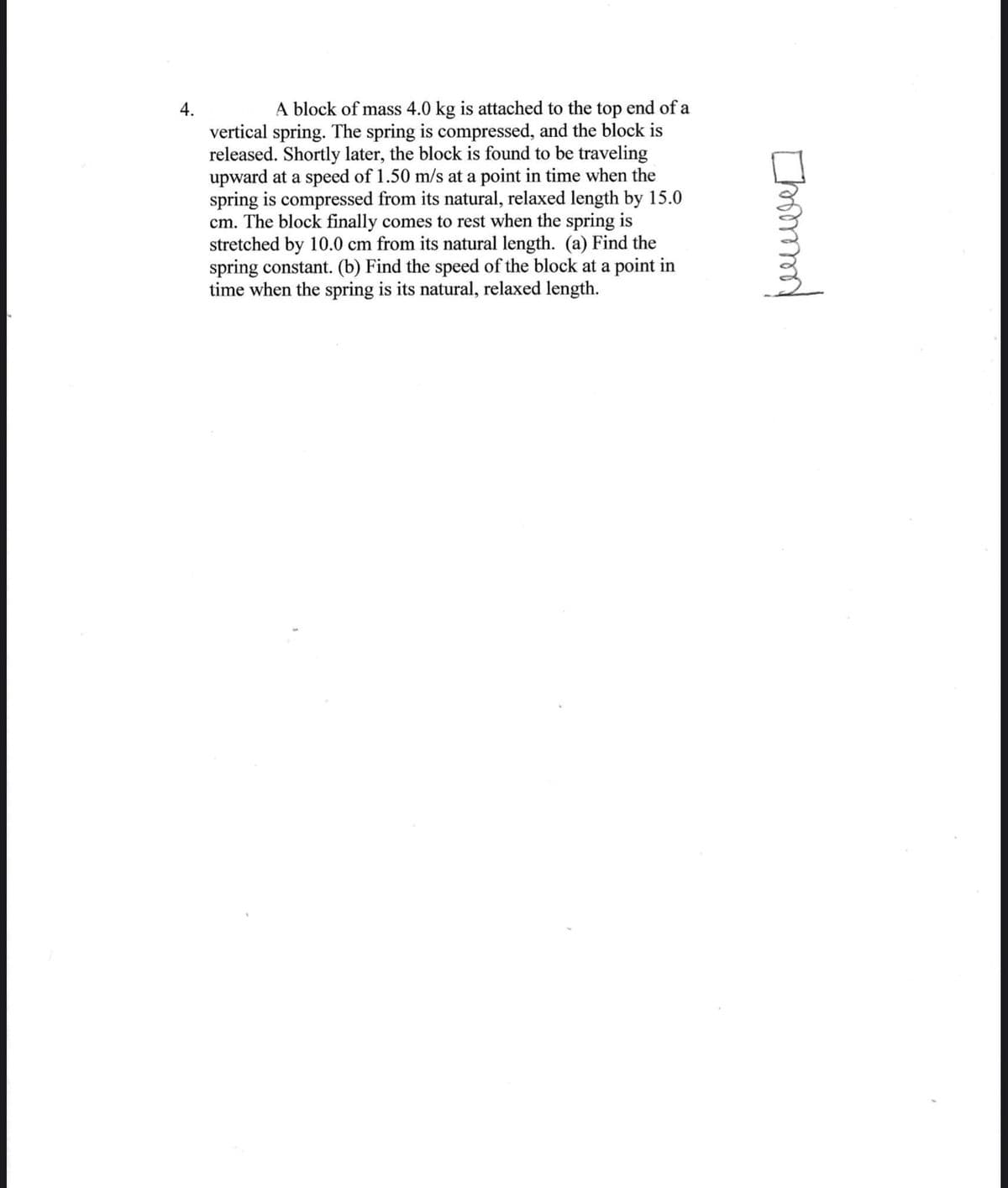A block of mass 4.0 kg is attached to the top end of a vertical spring. The spring is compressed, and the block is released. Shortly later, the block is found to be traveling upward at a speed of 1.50 m/s at a point in time when the spring is compressed from its natural, relaxed length by 15.0 cm. The block finally comes to rest when the spring is stretched by 10.0 cm from its natural length. (a) Find the spring constant. (b) Find the speed of the block at a point in time when the spring is its natural, relaxed length.
A block of mass 4.0 kg is attached to the top end of a vertical spring. The spring is compressed, and the block is released. Shortly later, the block is found to be traveling upward at a speed of 1.50 m/s at a point in time when the spring is compressed from its natural, relaxed length by 15.0 cm. The block finally comes to rest when the spring is stretched by 10.0 cm from its natural length. (a) Find the spring constant. (b) Find the speed of the block at a point in time when the spring is its natural, relaxed length.
Principles of Physics: A Calculus-Based Text
5th Edition
ISBN:9781133104261
Author:Raymond A. Serway, John W. Jewett
Publisher:Raymond A. Serway, John W. Jewett
Chapter7: Conservation Of Energy
Section: Chapter Questions
Problem 15P: A block of mass m = 2.00 kg is attached to a spring of force constant k = 500 N/m as shown in Figure...
Related questions
Question
PM1.4 please explain each step

Transcribed Image Text:A block of mass 4.0 kg is attached to the top end of a
vertical spring. The spring is compressed, and the block is
released. Shortly later, the block is found to be traveling
upward at a speed of 1.50 m/s at a point in time when the
spring is compressed from its natural, relaxed length by 15.0
cm. The block finally comes to rest when the spring is
stretched by 10.0 cm from its natural length. (a) Find the
spring constant. (b) Find the speed of the block at a point in
time when the spring is its natural, relaxed length.
4.
Expert Solution
This question has been solved!
Explore an expertly crafted, step-by-step solution for a thorough understanding of key concepts.
This is a popular solution!
Trending now
This is a popular solution!
Step by step
Solved in 2 steps with 2 images

Knowledge Booster
Learn more about
Need a deep-dive on the concept behind this application? Look no further. Learn more about this topic, physics and related others by exploring similar questions and additional content below.Recommended textbooks for you

Principles of Physics: A Calculus-Based Text
Physics
ISBN:
9781133104261
Author:
Raymond A. Serway, John W. Jewett
Publisher:
Cengage Learning

Physics for Scientists and Engineers
Physics
ISBN:
9781337553278
Author:
Raymond A. Serway, John W. Jewett
Publisher:
Cengage Learning

Physics for Scientists and Engineers with Modern …
Physics
ISBN:
9781337553292
Author:
Raymond A. Serway, John W. Jewett
Publisher:
Cengage Learning

Principles of Physics: A Calculus-Based Text
Physics
ISBN:
9781133104261
Author:
Raymond A. Serway, John W. Jewett
Publisher:
Cengage Learning

Physics for Scientists and Engineers
Physics
ISBN:
9781337553278
Author:
Raymond A. Serway, John W. Jewett
Publisher:
Cengage Learning

Physics for Scientists and Engineers with Modern …
Physics
ISBN:
9781337553292
Author:
Raymond A. Serway, John W. Jewett
Publisher:
Cengage Learning

Physics for Scientists and Engineers: Foundations…
Physics
ISBN:
9781133939146
Author:
Katz, Debora M.
Publisher:
Cengage Learning

Classical Dynamics of Particles and Systems
Physics
ISBN:
9780534408961
Author:
Stephen T. Thornton, Jerry B. Marion
Publisher:
Cengage Learning

College Physics
Physics
ISBN:
9781285737027
Author:
Raymond A. Serway, Chris Vuille
Publisher:
Cengage Learning